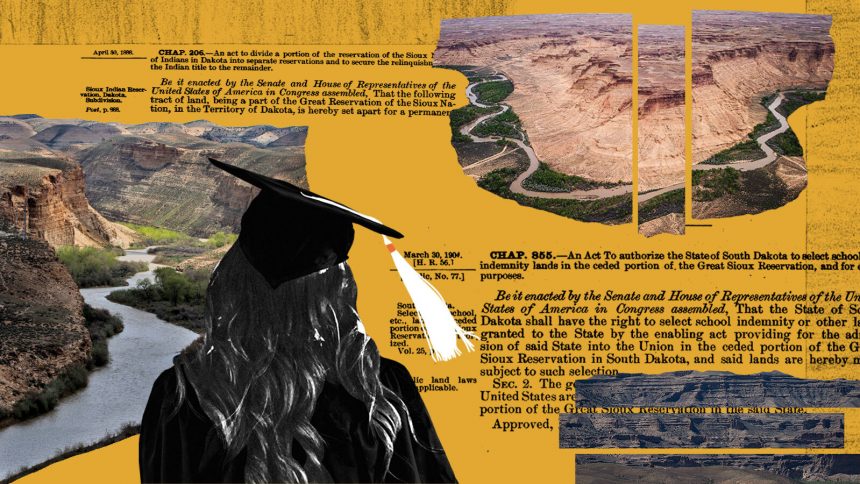**This story was published in partnership with High Country News. Before Jon Eagle Sr. began working for the Standing Rock Sioux Tribe, he was an equine therapist for over 36 years, linking horses with and providing support to children, families, and communities both on his ranch and on the road. The work reinforced his familiarity with the land, and allowed him to explore the rolling hills, plains, and buttes of the sixth-largest reservation in the United States. But when he became Standing Rock’s tribal historic preservation officer, he learned that the land still held surprises, the biggest one being that much of that land didn’t belong to the tribe. Standing Rock straddles North and South Dakota, and both states own thousands of acres within the tribe’s reservation boundaries.**
**“They don’t talk to us at all about it,” Eagle said. “I wasn’t even aware that there were lands like that here.” It wasn’t until John Eagle Sr. became Standing Rock’s tribal historic preservation officer that he learned that much of the reservation didn’t belong to the tribe.**
**On the North Dakota side, nearly 23,500 acres of Standing Rock are managed by the state, along with another 70,000 of subsurface acres, a land classification that refers to underground resources, including oil and gas. The combined 93,500 acres, known as trust lands, are held and managed by the state and produce revenue for its public schools and the Bank of North Dakota. The amount of reservation land South Dakota controls is unknown; the state does not make public its trust land data and did not supply it after a public records request. And Standing Rock isn’t alone.**
**Data analyzed by Grist and High Country News reveals that a combined 1.6 million surface and subsurface acres of state trust lands lie within the borders of 83 federal Indian reservations in 10 states. State trust lands, which are managed by state agencies, generate millions of dollars for public schools, universities, penitentiaries, hospitals, and other state institutions, typically through grazing, logging, mining, and oil and gas production. Although federal Indian reservations were established for the use and governance of Indigenous nations and their citizens, the existence of state trust lands reveals a truth: States rely on Indigenous land and resources to support non-Indigenous institutions and offset state taxpayer dollars for non-Indigenous people.**
**Tribal nations have no control over this land, and many states do not consult with tribes about how it’s used. Even in the obscure world of trust lands, states’ holdings within reservations have been almost completely unknown until now. Many of the experts Grist and High Country News reached out to, including longtime policymakers and leaders on Indigenous issues, were unfamiliar with state trust lands’ history and acreage. However, what sources did make clear is that the presence of state lands on reservations complicates issues of tribal jurisdiction in regards to land use and management and undercuts tribal sovereignty. According to Rob Williams, University of Arizona law professor and citizen of the Lumbee Tribe of North Carolina, this has broad implications for everything from the handling of missing and murdered Indigenous people to tribal nations’ ability to confront climate change.**
**“When there’s clarity about jurisdiction over Indian lands, it is easier for tribes to work with others to protect public safety, public health, and the natural environment,” said Bryan Newland, assistant secretary for Indian Affairs at the Department of Interior and citizen of the Bay Mills Indian Community. “It’s been the longstanding policy of the department to reduce ‘checkerboard’ jurisdiction within reservations by consolidating tribal lands and strengthening the ability of tribes to exercise their sovereign authorities over their own lands.” The creation of Indian reservations was followed closely by states entering the union, as were successful attempts by state governments to carve up and dissolve those tribal lands. Once states became part of the U.S., they received millions of acres of recently ceded tribal lands, many of which became trust lands. But as more settlers moved west, states pushed for more land.**
**In the late 19th and early 20th centuries, the U.S. government responded by carving up Indian reservations, parceling out small amounts of land to individual tribal members, then handing over “surplus” lands for states, settlers, and federal projects. Known as the Allotment Era, the federal policy moved approximately 90 million acres of reservation lands nationwide from tribal hands to non-Native ownership. According to Monte Mills, professor of law at the University of Washington and director of the Native American Law Center, allotment served a dual purpose: It broke up tribal power and gave non-Native citizens access to tribal lands and natural resources.**






